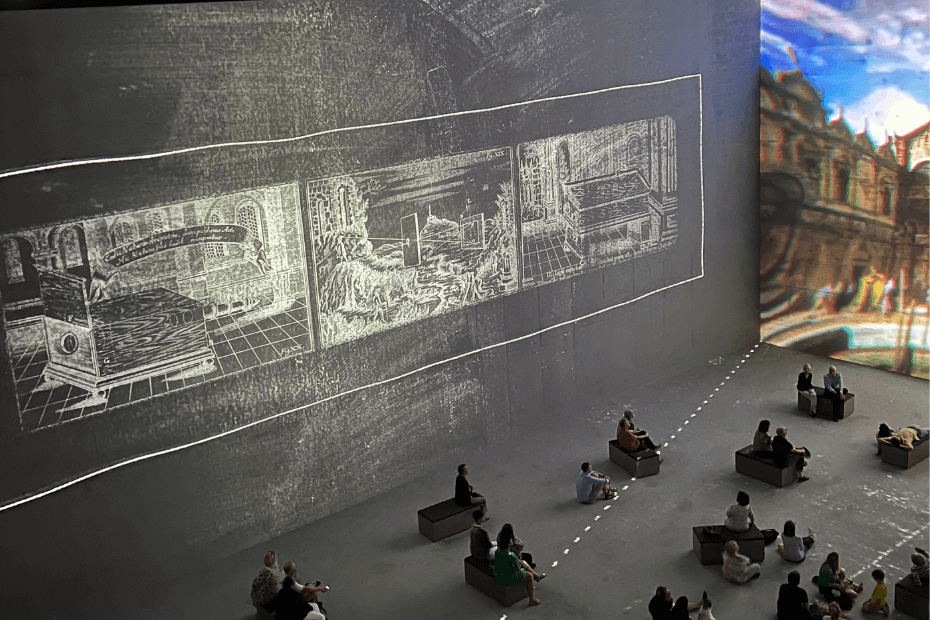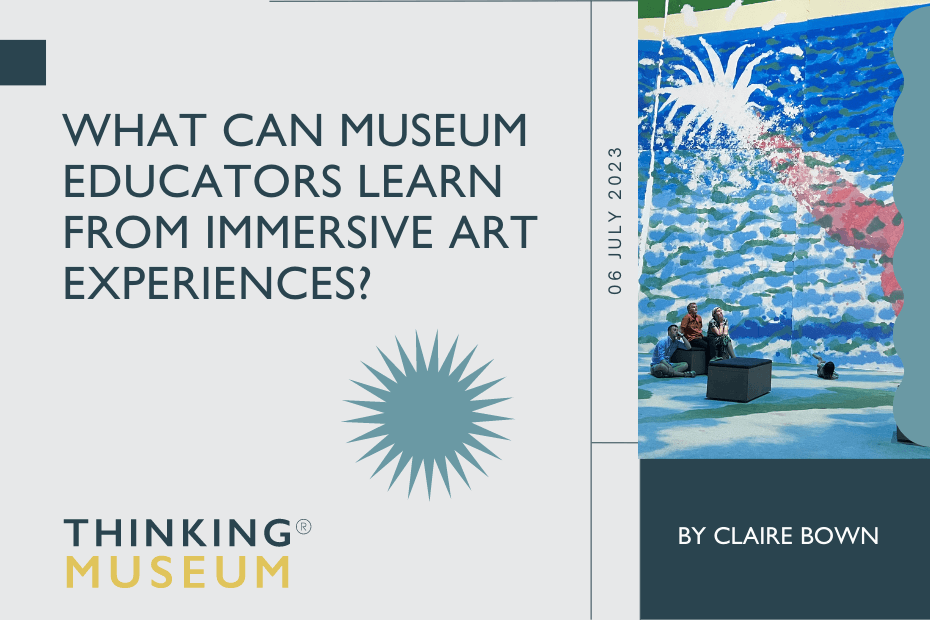Discover how museum educators can learn invaluable lessons from immersive art experiences. Drawing from my firsthand experience at David Hockney: Bigger and Closer in London, this post will share practical insights and approaches that museum educators can employ to enhance visitor engagement and forge deeper connections with art or objects in today’s dynamic museum landscape.
WHAT IS AN IMMERSIVE ART EXHIBITION OR EXPERIENCE?
Chances are, you’ve probably heard of or even been to an immersive art experience in the last few years. They seem to be everywhere.
An immersive art experience is like stepping into a living artwork, where you become an active participant.
It surrounds you with larger-than-life visuals, captivating sounds, and sometimes even interactive elements, transporting you to a different world.
According to the New Yorker magazine, they are ‘technology-driven “immersive” installations…Operated by artist studios, collectives, and production companies.’ Projects range ‘from sophisticated new-media installations to animated retrospectives of Impressionist painters’.
They incorporate technology, sound, lighting and interactive installations, stimulate multiple senses and create a sense of being actually ‘immersed’ in the artwork or the space.
The most well-known of these are the various Van Gogh immersive experiences – the earliest of which dates back to 2008 – which have proliferated around the world. But there are many more unique experiences taking place worldwide that offer viewers an opportunity to engage with art in innovative and immersive ways.
PROS AND CONS OF IMMERSIVE ART EXPERIENCES
But they are not without criticism. Some people feel that these experiences prioritise money over artistic integrity, exploiting an artist’s name for profit.
Some critics feel that these experiences can lead to a more superficial engagement with art that prioritises photo opportunities or novelty over deeper engagement.
Sometimes there can be a loss of context, without educational elements viewers may miss out on historical, cultural and artistic significance of the artworks.
And immersive art experiences can never fully replicate the experience of being up close to an original artwork.
Enthusiasts, on the other hand, argue that immersive art experiences do not aim to replace the experience of being in a museum with the original but, instead, offer an alternative and complementary approach to engaging with art.
They believe that these experiences have their own merits – they foster accessibility, enhanced engagement, interpretative opportunities, and emotional resonance that can be equally valuable and transformative for viewers.

WHAT DO MUSEUMS THINK?
But I feel as museum educators we can learn from immersive experiences. Museums are actively seeking strategies to reenergise and attract audiences. In the next 5-10 years more museums will embrace immersive experiences as a means to engage audiences and will collaborate with artist studios, collectives, and production companies, to bring these immersive experiences to a wider audience within museums.
Immersive art experiences are often not very educational in themselves, but they might tempt more audiences into educationally-orientated organisations such as museums as well.
DAVID HOCKNEY: BIGGER AND CLOSER
In June I visited David Hockney: Bigger and Closer at the Lightroom in London.
This experience uses large-scale projection to delve into Hockney’s artistic journey over the last 60 years.
It aims to provide a personal perspective, allowing viewers to see the world through Hockney’s eyes and gain a deeper understanding of his artistic vision.
It’s different because it’s narrated by Hockney himself.
It invites us to look closely at Hockney’s artworks, to see and experience how they were created or what inspired them. We notice the intricacies colours and details more. It’s also a joyful positive experience, it’s playful and uplifting.
It definitely challenged my assumptions about immersive art experiences and got me thinking. What can we learn from immersive art experiences?
WHAT CAN MUSEUM EDUCATORS LEARN FROM IMMERSIVE ART EXPERIENCES?
‘Immersion’ experiences with art can offer valuable lessons to museum educators in designing their own programs with groups in the museum. Here are some key aspects that museum educators can learn from immersion experiences:
So let’s talk first about active engagement.
Immersive art experiences frequently go beyond passive observation and encourage active participation from viewers.
Active engagement is about encouraging individuals to interact, respond, and contribute actively to the experience.
In immersive art experiences, active engagement can take various forms – there may be physical elements that viewers can interact with, such as installations or sculptures that invite viewers to touch, move, or manipulate certain components.
How can you bring in hands-on elements to allow participants to interact directly with art materials or replicas. How can you use supplementary materials and visual aids to allow active engagement?
Immersive art experiences often stimulate multiple senses. Participants may be encouraged to listen to soundscapes, experience different textures, or even smell specific scents associated with the artwork. By engaging various senses, individuals actively immerse themselves in the artwork and experience a more holistic engagement.
So, how can you use sound to engage participants with an artwork or object? Or provide tactile materials to allow participants to explore different textures? How can you draw attention to the sensory aspects of artworks or objects in your museum and gallery programmes, encouraging participants to listen, touch, or observe closely. What prompts and questions can you provide that stimulate sensory perception?

Movement and navigation: Some immersive art experiences incorporate spatial design that encourages viewers to move through the exhibition space. Participants might navigate different rooms or pathways, experiencing the artwork from different angles or perspectives. This active movement and navigation allow individuals to shape their own journey and engagement with the art.
Immersive art experiences pay attention to spatial and environmental design to create a specific atmosphere or ambiance that enhances the overall experience. Museum educators can consider the physical environment of their programs and explore ways to create an immersive and conducive space for learning. This can involve careful selection of artworks, arrangement of seating, lighting, and even incorporating multimedia elements to enhance the atmosphere.
How can you incorporate movement into your programmes? Instead of simply standing in front of artworks, participants can be encouraged to walk around, explore different viewpoints, and experience the artworks or objects from various angles. See my free guide How to Look at Art Slowly for lots of ideas on movement.
We can also learn from the way viewers navigate the space in immersive art experiences. When I was at the Hockney experience, there were people that were sitting down on benches or on the floor, leaning, standing and children running around and playing.
Think about opportunities for participants to sit or provide flexible seating options within the learning spaces to accommodate different preferences and needs. Create a more relaxed and inviting atmosphere, enabling participants to engage with the content in a way that suits them best.
Give participants some choice and agency over what they see. Allow participants to go and explore artworks in pairs and then report back to you at a designated spot and a designated time. Give them a question to puzzle over or something to find.
This gives participants more freedom and allows them to relax. Participants in the immersive art experiences weren’t worrying about keeping quiet or behaving in a ‘museumy’ way. They were just being themselves. And we can take a lot from that too.
We can also embrace and emphasise the power of scale: “Bigger and Closer” is known for its large-scale digital artworks, which immerse viewers in a visually expansive environment.
How can you use scale to capture participants attention, create awe and stimulate curiosity? What large-scale pieces or spaces can you use? See here for 6 ways to create awe- inspiring experiences with art and objects.
On the Lightroom website, there is a quote from David Hockney that I particularly like:
“The world is very, very beautiful if you look at it, but most people don’t look very much. They scan the ground in front of them so they can walk, they don’t really look at things incredibly well, with an intensity. I do.”
DAVID HOCKNEY
This immersive art experience really allows you to look closely at Hockney’s work.
The large scale of the projections brings attention to the intricate details, brushwork, and colour choices that may not be as noticeable when viewing the artworks in traditional sizes.
Also, by showing a comprehensive journey through Hockney’s artistic career, this immersive experience allows us to observe the changes, developments, and recurring motifs in his work. Essentially, It encourages us to look closely and appreciate the technical aspects of Hockney’s work.
So how can we encourage our participants to develop and hone their observation skills? How can we encourage slow looking?
Spend time with artworks and object. Look closely and slowly together. Help participants to notice the details, and beauty that might otherwise go unnoticed.
We can also use technology to enhance details – take an iPad or a close up print out of a high resolution image to show things that we can’t see with the naked eye.
Draw attention to colours, details, and intricacies within artworks. Guide participants to notice specific elements, textures, brushstrokes, or composition choices to cultivate the skill of observing more closely.
And finally Create a joyful and playful atmosphere.
Immersive art experiences are fun. So let’s create positive and welcoming environments and approach artworks or objects with a sense of curiosity, exploration, and joy. This mindset encourages participants to look more closely, engage actively, and derive greater enjoyment from the experience. See here for some ideas on how to incorporate a more playful attitude to your museum and gallery programmes.
Let’s end with a question.
Ask yourself this:
How can you apply some of these ideas into your museum and gallery programmes?
And what strategies will you implement to create a more immersive experience for your participants?
